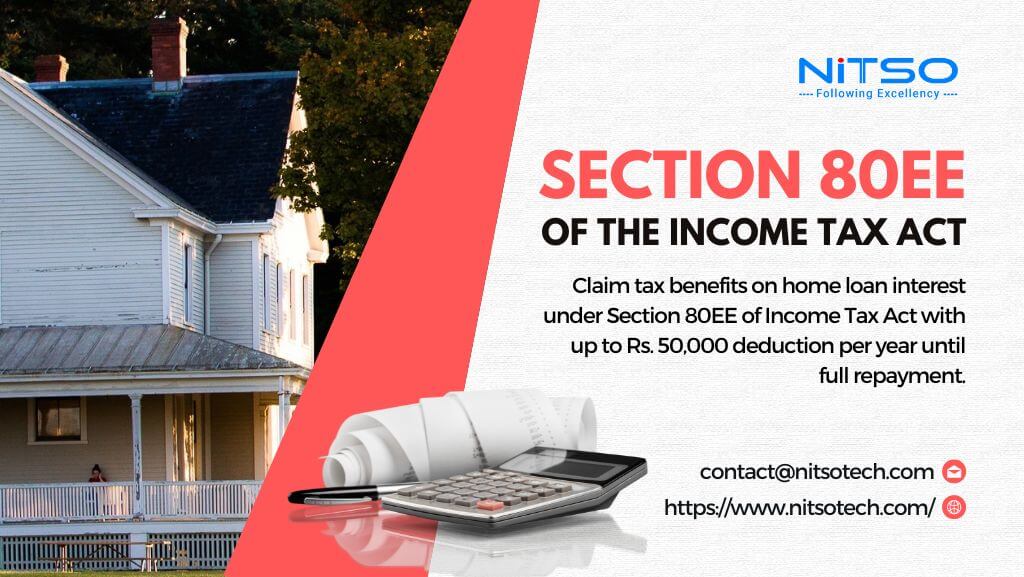Section 80EE of the Income Tax Act of India was introduced in 2013 to encourage individuals to invest in their own homes. The deduction under Section 80EE was introduced for first-time home buyers who are looking to purchase a home. Sec 80EE allows individuals to claim an additional deduction of up to Rs 50,000 on the interest paid on their home loan. This is over and above the Rs, 2 lakh limit provided under Section 24 of the Income Tax Act.
Table of Contents
Eligibility Criteria for Claiming Section 80EE Deduction
To claim a Section 80EE deduction, there are certain eligibility criteria that an individual must meet. Here is an overview of the eligibility criteria for claiming a Section 80EE deduction:
- The deduction is available only to individuals and not to HUF, AOP, or any other entity.
- The individual must be a first-time home buyer, meaning they should not have owned any residential property in India or anywhere else in the world.
- The home loan must have been sanctioned between April 1, 2016, and March 31, 2017.
- The loan amount should not exceed Rs 35 lakhs.
- The value of the residential property should not exceed Rs 50 lakhs.
It is important to note that if an individual has already claimed a deduction under Section 80EE for a particular year, they cannot claim the same deduction for any other year.
Who can claim a deduction under Section 80EE?
Only individuals who meet the above eligibility criteria can claim a deduction under Section 80EE. Additionally, the deduction is available only for the interest paid on the home loan and not for the principal amount. The individual can claim the deduction only after they have taken possession of the property.
Conditions for claiming Section 80EE deduction
To claim a deduction under Section 80EE, there are certain conditions that an individual must fulfill. Here are the conditions for claiming Section 80EE deduction:
- The loan must be taken from a financial institution such as a bank or a housing finance company.
- A loan must be taken to buy or construct a residential property.
- The individual must not have any other existing residential property on the date of sanction of the loan.
- The individual must not have availed of any other deduction for interest on a housing loan under any other provision of the Income Tax Act.
It is important to note that if the individual fails to comply with any of the above conditions, the deduction claimed under Section 80EE will be disallowed by the Income Tax Department. Therefore, ensuring that all conditions are met before claiming the deduction is crucial.
How to Claim Deduction Under Sec 80EE
To claim a Section 80EE deduction, an individual must follow certain steps and provide specific documents. Here are the steps to claim a deduction under Section 80EE of the Income Tax Act:
-
Fill in the details of the home loan and the interest paid in the Income Tax Return form.
-
Provide the certificate of interest received from the financial institution where the home loan was taken.
-
Submit a copy of the loan sanction letter.
-
Ensure that the conditions for claiming Section 80EE deduction are met.
It is important to remember that the deduction can be claimed after the possession of the property has been taken. Also, ensure that all necessary documents are in place to avoid any delays or disallowance of the deduction.
Tips to Keep in Mind While Claiming Section 80EE Deduction
Here are a few tips to keep in mind while claiming a deduction under Sec 80EE:
- Ensure that the eligibility criteria and conditions for claiming deduction are met.
- Keep all the necessary documents in place.
- File the Income Tax Return on time.
- Keep a record of the deductions claimed and the amounts.
What will be the total tax benefit under Section 80EE and Section 24?
The total tax benefit under Section 80EE and Section 24 of the Income Tax Act can be significant. Under Sec 80EE, an individual can claim a deduction of up to Rs. 50,000 on the interest paid on the home loan in a financial year. Additionally, under Section 24, an individual can claim a deduction of up to Rs. 2 lahks on the interest paid on the home loan in a financial year.
Therefore, the total tax benefit an individual can claim under both sections can be up to Rs. 2.5 lakhs in a financial year. This can help individuals reduce their tax liability and save significant money. Individuals must ensure that they meet the eligibility criteria and conditions for claiming the deductions under both sections to take advantage of the tax benefits available to them.
Conclusion
Section 80EE of the Income Tax Act provides a deduction for interest paid on home loans taken from a financial institution. Individuals must understand the eligibility criteria, coverage, and conditions for claiming the deduction. Claiming the deduction can help individuals save on tax liability and reduce overall expenses.
In conclusion, Sec 80EE is an important provision under the Income Tax Act that offers a deduction to individuals who have taken a home loan. It is important for individuals to take advantage of this deduction and ensure that they meet all the conditions for claiming the deduction. By doing so, individuals can reduce their tax liability and save on expenses.
Related Articles:
- Understanding Section 10 of the Income Tax Act in India
- Tax Rebate Under Section 87A of the Income Tax Act in India
- What are 80U Deductions and the benefits of having an 80U deduction?
FAQs (Frequently Asked Questions)
How Many Times Can We Benefit from Sec 80EE?
Sec 80EE provides tax benefits on the interest component of the home loan obtained from any financial institution. This section allows you to claim a maximum deduction of Rs. 50,000 per financial year. You can avail of this deduction until you fully repay your home loan.
How much can I claim 80EE?
Under Section 80EE of the Income Tax Act, an individual can claim a deduction of up to Rs. 50,000 on the interest paid on a home loan in a financial year. This deduction is over and above the deduction of Rs. 2 lahks available under Section 24 of the Income Tax Act.
What is the difference between 80EE and 80EEA?
Sec 80EE and Sec 80EEA are related to the deduction of interest on home loans. The main difference between these two sections is that while Sec 80EE allows for a deduction of up to Rs. 50,000 on the interest paid on a home loan for first-time home buyers, Sec 80EEA allows for a deduction of up to Rs. 1.5 lakh on the interest paid on home loans for affordable housing. Visit to know more about Section 80EEA of Income Tax Act.
Which is best, 80EE or 80EEA?
Whether Section 80EE or Section 80EEA is best depends on an individual’s circumstances. If an individual is a first-time home buyer and has taken a home loan, then Sec 80EE may be more beneficial. However, if an individual has taken a home loan for affordable housing, Sec 80EEA may be more beneficial.
Who is eligible for 80EE and 80EEA?
Under Sec 80EE, only first-time home buyers are eligible for the deduction. Under Sec 80EEA, individuals who have taken a home loan for affordable housing are eligible for the deduction.
Can I claim both 80EE and 80EEA?
No, an individual cannot claim both Section 80EE and Section 80EEA. An individual can only claim a deduction under one of the sections based on their eligibility criteria.
What are the conditions for the Sec 80EEA deduction?
The conditions for claiming a deduction under Section 80EEA include that the home loan should have been taken between April 1 2019, and March 31 2022. The stamp duty value of the property should not exceed Rs. 50 lahks and the individual should not own any other residential property at the time of sanction of the loan.
Is a loan against property covered under Section 80EE?
No, a loan against property is not covered under Sec 80EE. The deduction under this section is only available for first-time home buyers who have taken a home loan to purchase a residential property.
Is Section 24 and 80EE the same?
No, Section 24 and Section 80EE are not the same. Section 24 provides a deduction on the interest paid on a home loan. In contrast, Section 80EE provides an additional deduction on the interest paid on a home loan for first-time home buyers.
Can I claim both Section 24 and Section 80EE?
Yes, an individual can claim both Section 24 and Section 80EE deductions. Under Section 24, an individual can claim a deduction of up to Rs. 2 lahks on the interest paid on a home loan in a financial year. Additionally, under Section 80EE, an individual can claim a deduction of up to Rs. 50,000 on the interest paid on a home loan in a financial year.
What is the difference between section 24B and section 80EE?
Section 24B applies to all homebuyers who have taken a home loan, while Sec 80EE applies only to first-time homebuyers. Moreover, the maximum deduction amount available under Section 24B is higher than that available under Sec 80EE. Therefore, homebuyers need to understand the difference between these two sections and choose the one that suits them best based on their circumstances.
Can I claim HRA and 80ee?
Yes, claiming both HRA (House Rent Allowance) and Section 80EE deduction simultaneously is possible. However, certain conditions must be met to claim these tax benefits.
HRA is a component of your salary that your employer pays to cover your rental expenses. You can claim tax deductions on HRA if you live in a rented house and receive HRA as a part of your salary. On the other hand, Section 80EE provides a deduction on the interest paid on a home loan for first-time homebuyers.
If you live in a rented house and receive HRA, you can still claim the deduction under Sec 80EE for the interest paid on your home loan. However, to claim the deduction under Sec 80EE, you must have taken a home loan for the first time, and the loan should be for purchasing your first home. Additionally, the loan should be taken between April 1, 2016, and March 31, 2017, and the overall value of the purchased residential property should be Rs. 50 lakhs or less.








0 Comments